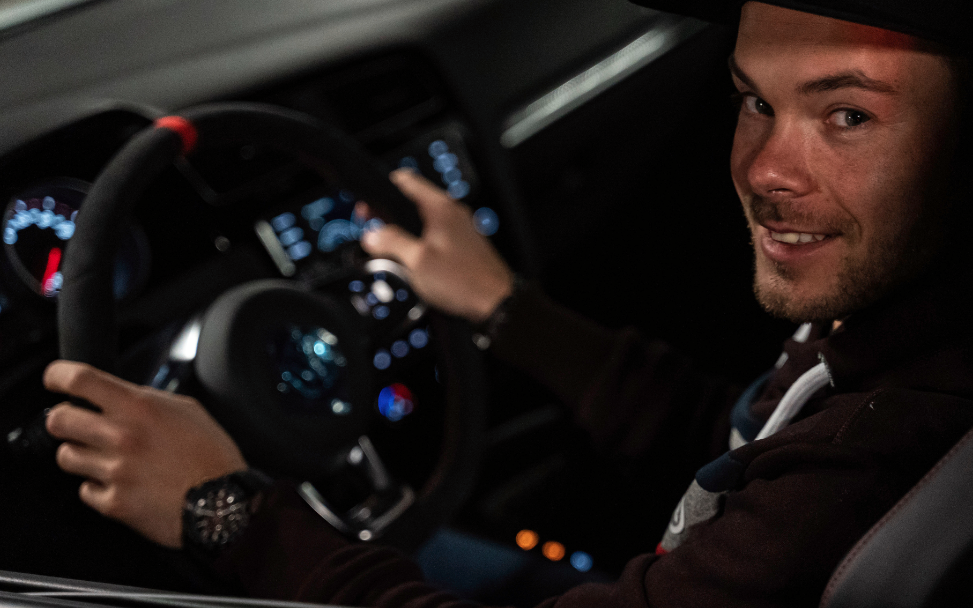
It’s the one we have all been waiting for! The Golf GTI is considered an icon for motoring enthusiasts not just here in Ireland but around the world. The handling characteristics are more often than not, second to none and its the Golf we all relish to use as our everyday mode of transport. Launched at the International Motor Show in Frankfurt in September 1975, the first Golf GTI was young and wild. As of the summer of 1976 it stormed into an automotive category that hadn’t actually existed until that moment – compact sports cars with front-wheel drive. 5,000 GTI units had been planned. This quickly turned out to be a fabulous misconception. The new vehicle immediately became an icon because the affordable Golf GTI turned the automotive order upside down by breaking into the expensive sports cars segment and bringing driving dynamics to the masses. And consequently a total of 461,690 Golf GTI Mk1 rolled off the production lines. The first Golf GTI has long since become a timeless classic. With its six successors to date, it has become the world’s most successful compact sports car. More than 2.3 million units of the Golf GTI had been produced by the end of 2019. It has become a phenomenon. However, revolutionary ideas require evolutionary development. The first Golf GTI’s DNA lives on to this day in the agile front-wheel drive, sporty running gear, perfect ergonomics and authentic design. Some 45 years after the first GTI’s world première, Volkswagen is now launching the eighth generation. The first Golf GTI of the digital age will be a brand new, networked and fully-fledged sports car. The eighth Golf GTI is also the most digital GTI of all time. Its entire electronic architecture has been created from scratch. And that changes everything. The new generation of software and hardware is tangible inside and when driving the vehicle. On the interior, drivers have access to a digitally networked world of displays and controls. This enables the driver to customise the visual look and technology of their Golf GTI more intuitively and in greater detail than ever before. The driver can decide on functions including the colour range of the background lighting, the individual configuration of the Infotainment system, the Digital Cockpit and the engine sound – they also have a greater influence on their Golf GTI’s handling characteristics than previously. The new Vehicle Dynamics Manager control system makes its debut in the Golf GTI, and it certainly shows its full potential. The Vehicle Dynamics Manager controls the XDS electronic differential lock, (electronically regulated) front-axle locking differential functions, now a standard feature across the board, and also the lateral dynamics ratio of the optionally controlled damping system (DCC) that forms part of the new GTI running gear setup. Drivers can customise their setup using the standard driving mode selection feature and the gradually adjustable DCC running gear. Electromechanically adjustable running gear systems once again significantly enhance the balance between maximum dynamics and the highest levels of comfort. In this process, sharper driving dynamics guarantee a completely new and unadulterated driving experience as the eighth Golf GTI handles extremely accurately and is agile to drive despite its unrivalled long-distance comfort. For example, running gear engineers have in effect entirely eliminated understeer, a typical characteristic of front-wheel drive vehicles whereby the vehicle’s front wheels tend to lose grip through quick corners. The new Golf GTI races through corners extremely neutrally, even at high speeds on race tracks, and also accelerates out of corners without any loss of traction.
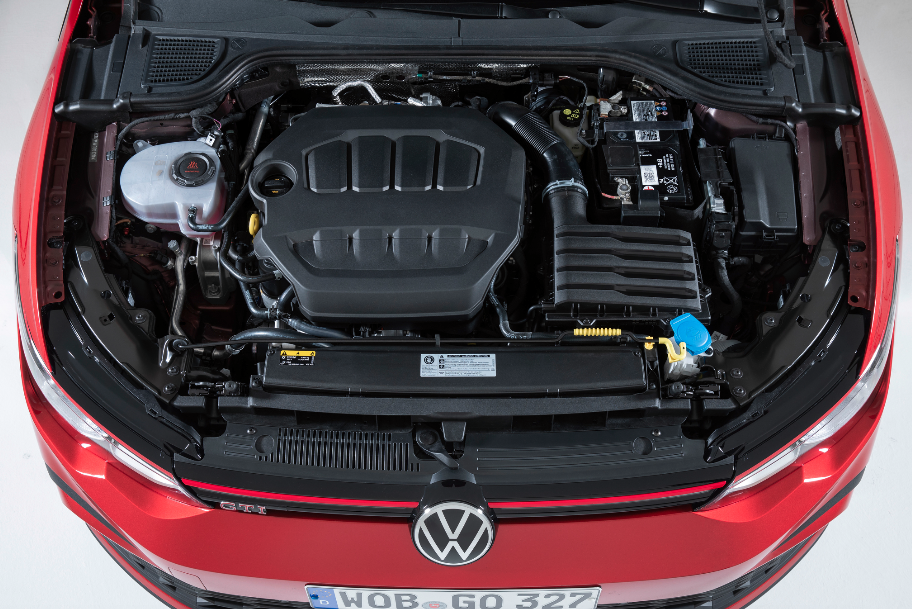
The new Golf GTI is powered by a 245 PS 2.0-litre turbocharged direct injection engine (TSI). The maximum torque is 370 Nm. The GTI engine (EA888 evo4) in this output level had been reserved for the predecessor Golf GTI Performance 230 PS at peak. Now the 245 PS engine is part of the standard range. The TSI unit has been coupled with a manual 6-speed gearbox – a combination that is a firm favourite with sports car purists. An extremely quick-shifting 7-speed dual clutch gearbox (DSG) is available as an optional alternative. The electronically limited top speed is 250 km/h in both cases (full power and consumption values will follow homologation approval). Compared with the predecessor the new Golf GTI has become flatter, more elongated and dynamic. Designers created each body part from scratch and worked with aerodynamicists to perfectly hone the vehicle in the wind tunnel. The drag coefficient (Cd) of the basic model dropped from 0.3 to 0.275. The aerodynamics have also been improved by a range of individual measures. These include Cd-optimised exterior mirrors, aerodynamic corners and a bespoke GTI roof spoiler, extensive underbody panelling as well as aerodynamically optimised features in the wheel housing liners (displacement elements at front, spoiler at rear). The new sports car also features a range of traditional and completely new exterior GTI features. The red strip in the radiator grille is imperative for a GTI. This strip originates from the first GTI generation in which it completely framed the plastic radiator grille. Today this red strip stretches across the vehicle’s entire front above the radiator grille and merges with the wings. For the first time the red GTI strip is refined by a parallel LED crossbar at the bottom. In each case, this LED crossbar stretches from the outside of the standard LED headlights to the VW badge arranged in the centre of the radiator grille. This gives the Golf GTI a new and unmistakeable light signature. The bottom section of the front panel also features GTI-specific design with the typical, black, honeycomb air intake. LED fog lights designed in a brand new X formation are available as an optional extra. Other exterior GTI characteristics include the front spoiler, side sills and rear diffuser frame, forming an all-round design unit. The 17-inch Richmond alloy wheels that come as standard have also been designed exclusively for the new Golf GTI. The exhaust system’s tailpipes, arranged to the left and right of the rear diffuser, as well as chrome/red GTI badges on the front wings, the tailgate and on the radiator grille are also specific to the Golf GTI.
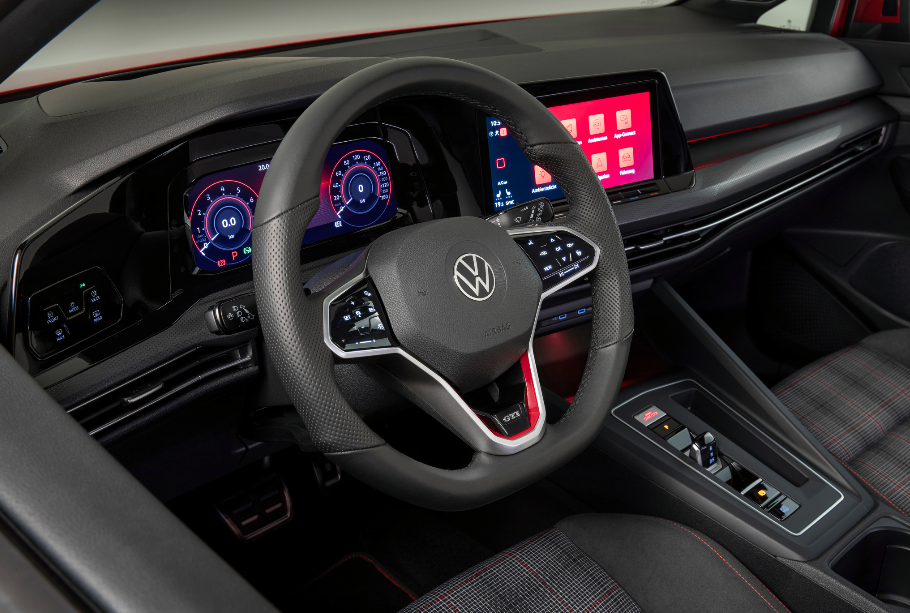
Interior highlights include new sports seats with integrated head restraints that are reminiscent of the first Golf GTI thanks to their special ergonomics, red stitching and a tartan Scalepaper style fabric on the seat and backrest areas. It goes without saying that the new multifunction sports steering wheel has been individually designed with a red appliqué and the GTI badge. Another typical Golf GTI feature is the honeycomb pattern on the dash panel and door trim. The new Engine Start/Stop button comes as standard in the Golf GTI. Once the doors have been opened, it pulses red until the engine has been started. UX designers have also developed a new GTI graphic for the standard Digital Cockpit. It can be opened using the new View button on the steering wheel. It is made up of a combination of three round instruments: the rev counter with GTI logo in the centre surrounded by one round instrument each on the left and right. These can be individually assigned, for instance to show the engine’s boost pressure or the current power output.
Every new Golf is fitted with assist systems such as the Lane Assist lane keeping system, Autonomous Emergency Braking Front Assist with Pedestrian and Cyclist Monitoring, XDS electronic differential lock and also Car2X (local communication with other vehicles and the traffic infrastructure). In the interior the Digital Cockpit and standard 8.25-inch Composition infotainment system have been digitalised and integrated into a network, providing We Connect and We Connect Plus online services and functions. Other standard features include a multifunction steering wheel, single-zone automatic climate control, the Press & Drive comfort start system, a Bluetooth provision for mobile telephone, LED headlights, LED tail light clusters, LED daytime running lights, LED reading lights and two USB-C ports. This range of equipment has been extended significantly for the GTI.
On the exterior, the equipment outlined here is supplemented by 17-inch alloy wheels, a customised front section, a grooved rear diffuser, a standalone roof spoiler, the corresponding model logos, individual tailpipes, red brake calipers and sill extensions. The functions include a sports running gear (lowered by 15 mm), a front-axle locking differential, sound actuator and the Keyless Access locking and starting system. All pedals are made of stainless steel. Pre-sales of the new Golf GTI will start this summer.
The design of the new Golf GTI embodies sporty charisma. The GTI has become faster, more efficient and safer in terms of its driving dynamics thanks to superlative aerodynamics (cd = 0.275). Standard LED headlights have been arranged low down. These are optionally available as IQ.LIGHT – LED matrix headlights. They form a striking crossbar in conjunction with the radiator grille. A slim, red GTI line towards the top of the bonnet now stretches across the front section. An LED strip in the headlight mirrors the red line when the daytime running lights are activated – or when the driver approaches with the key. As an optional extra, the radiator grille can now be illuminated as a continuation of the LED strip for the first time. This creates a completely new, unmistakable headlight design.
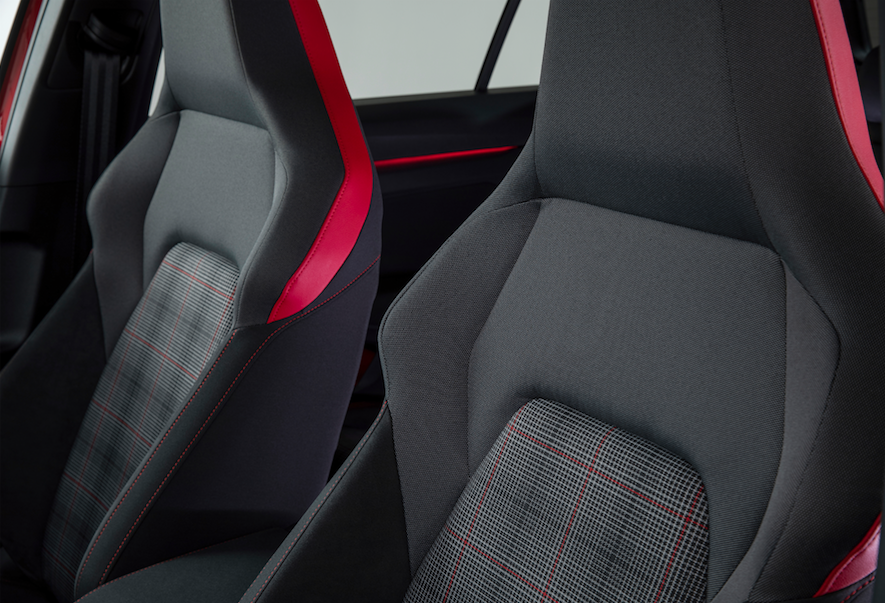
Another striking and unmistakable feature is the large, single-piece lower air intake grille in typical GTI honeycomb pattern. It is framed on the outside by a black appliqué, with a striking wing-like design on the sides. The new GTI insignia also include the optional fog lights which have now been integrated into the air intake grille in an X formation. The 17-inch Richmond alloy wheels fitted as standard catch the eye from a side view. These GTI wheels are optionally also available in an 18-inch version. The range of wheels additionally includes further 17, 18 and 19-inch alloy wheels. Red brake calipers always form part of the standard equipment. On the side of the front wing the GTI also features a signet consisting of the three iconic letters G, T and I. A bespoke spoiler extends the roof line at the very top of the vehicle silhouette. The design element that stands out on the side is the traditional C-pillar, a feature shared by both the standard Golf and its GTI variant. It visually propels the vehicle body forwards and transposes the iconic graphics of the original GTI into the modern era. As outlined, the new Golf has a powerful shoulder section and a strong rear end design. This element can also be found on the Golf GTI. The GTI lettering is now positioned centrally under the new Volkswagen emblem rather than on the driver side as it was before. The Golf GTI appears to be even flatter than less powerful Golf models thanks to the roof spoiler that extends significantly towards the rear (painted in the vehicle colour at the top, glossy black at the bottom). Down below, the sporty diffuser distinguishes the new edition of this icon from the other versions of the product line with smaller engines. In keeping with GTI tradition, the new model’s exhaust system has one tailpipe on the left and one on the right.
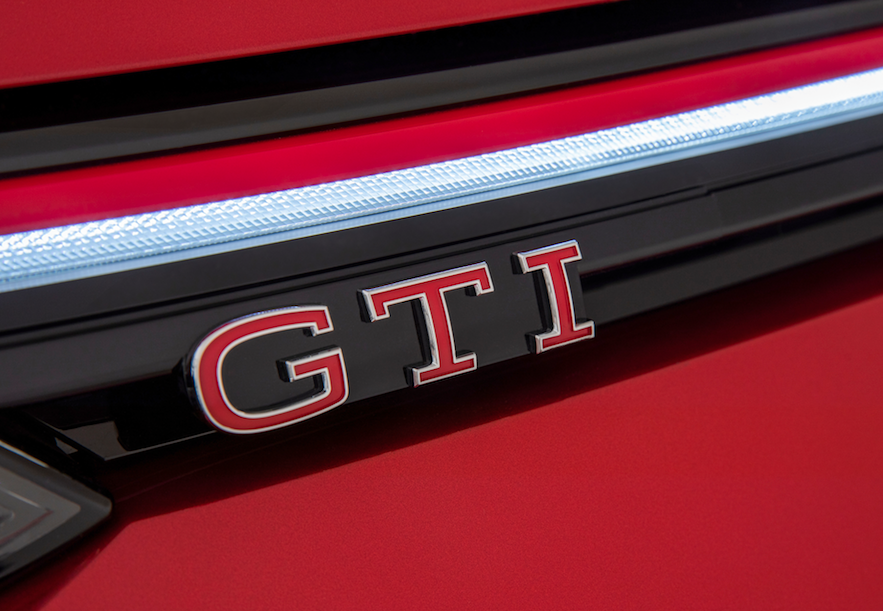
Ever since the first Golf GTI made its debut, this car has been like a perfectly fitting pair of jeans. Right from the outset, Volkswagen created distinctive, unmistakeable GTI insignia with the multitude of interior details – the sports steering wheel featuring three silver double spokes and recessed Wolfsburg emblem on the impact absorbing element, the gear knob in the shape of a black golf ball, GTI sports seats in tartan with black side bolsters – all of which have long since become classic design elements. Although Volkswagen is enhancing the digital and networking capabilities of the eighth-generation Golf – and with it the GTI – to an unprecedented extent in order to future-proof the range, many of the original insignia can still be found on board. However, the sports steering wheel of yesteryear has been transformed into a new multifunction leather sports steering wheel with touch controls and an optional Travel Assist button to help the powerful Golf reach a top speed of 210 km/h while Travel Assist is engaged. The three silver spokes have been retained – in the GTI the centre spoke has been upgraded with a red interior. The classic checked pattern of the new sports seats development is also a must. The tartan design is now called Scalepaper (featuring red seams with grey and black tartan). Red is also used for all decorative seams and edging. The Golf GTI’s digital displays start up as soon as the doors are opened. They are a fusion of the standard Digital Cockpit (digital instruments) and the Infotainment system. Composition, featuring an 8.25-inch screen, is installed in this vehicle as standard while the 10-inch Discover Pro system is available as an optional extra for the most advanced expansion package. If Discover Pro has been installed in the vehicle, it merges with the Digital Cockpit to form the Innovision Cockpit, offering further enhanced functionality. Regardless of which Infotainment system is on board the Golf GTI, the visual and functional fusion of systems creates a new and consistent digital architecture. Background lighting, which comes as standard, embeds the displays and all other illuminated interior areas (dash panel, door trim, storage compartment with interface for mobile telephone, footwell) in a spectrum of 30 configurable colours. The GTI gear knob was specifically designed for the standard, manual six-speed gearbox. The new Golf GTI is optionally also available with an automatic 7-speed dual-clutch gearbox (DSG). The functionality of the standard Engine Start/Stop button has been customised – once the doors have been opened, it pulses red until the 245-PS TSI engine has been started.
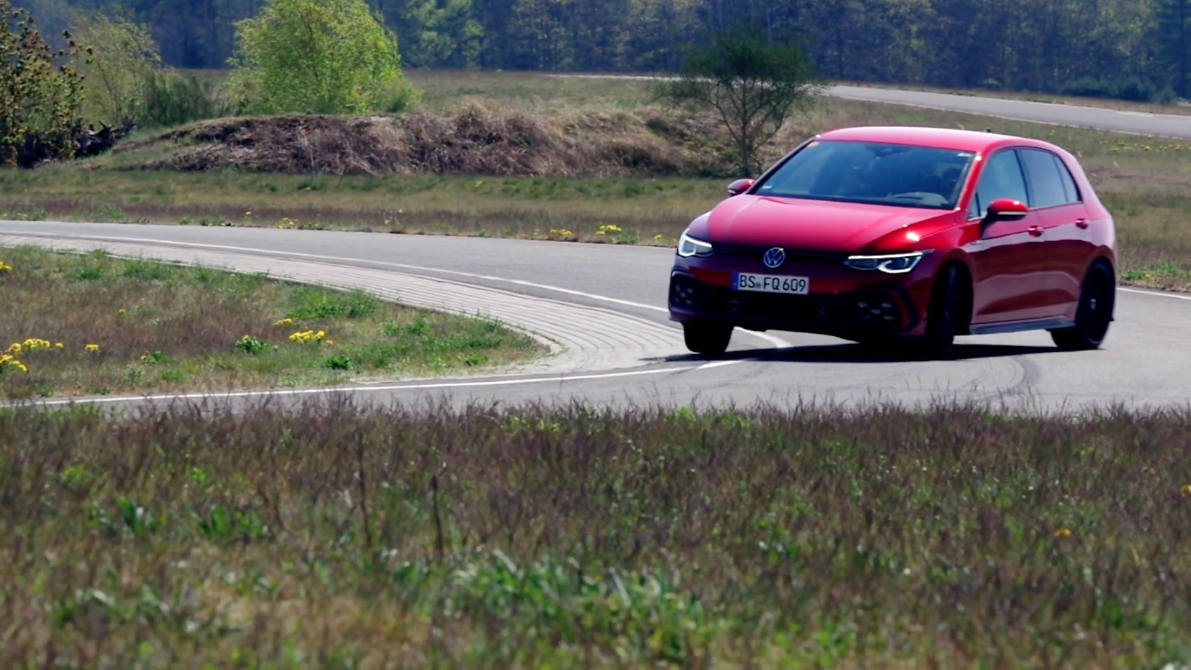
The Vehicle Dynamics Manager coordinates and activates the functions of the electronically controlled front-axle locking differential, the electronic XDS differential lock as well as the lateral dynamic components of the optional electronically controlled shock absorbers (DCC) during every driving manoeuvre. In this process, adapting the individual wheel damping (200 times a second) guarantees particularly agile and accurate handling. Running gear engineers have introduced a new technical package to entirely eliminate understeer, a typical characteristic of front-wheel drive vehicles whereby the vehicle’s front wheels lose grip in quick corners. The Golf GTI races through corners extremely neutrally, even at suitably high speeds on race tracks, and also accelerates out of corners without any loss of traction. This is due in part to the fact that the locking torque of the front-axle locking differential can be significantly increased in Sport mode. Talking of race tracks, it is possible to adapt the ESC intervention in two stages. In ESC Sport mode the ESC thresholds and ASR slip thresholds are increased to reduce the intensity of interventions. In ESC Off mode, ambitious drivers can additionally deactivate ESC altogether. However, Front Assist and Swerve Assist reactivate ESC in emergencies.
As was previously the case in the Golf GTI Performance and the Golf GTI TCR (213 kW/290 PS), Volkswagen is now equipping the new Golf GTI with an electronically controlled front-axle locking differential as standard. Compared with fully mechanically operated differential locks, the system in the Golf GTI offers benefits including a variable degree of intervention, full integration into the Vehicle Dynamics Manager, and ESC, EDS and XDS+ functions. This makes it possible to completely avoid negative influences on steering precision, as is the case with mechanical locking differentials. Thanks to a multi-plate clutch, the locking differential optimises grip and handling in fast corners, thus enhancing the performance and ultimately providing additional driving pleasure. The front-axle locking differential eliminates front-wheel drive vehicles’ disadvantages in relation to grip.
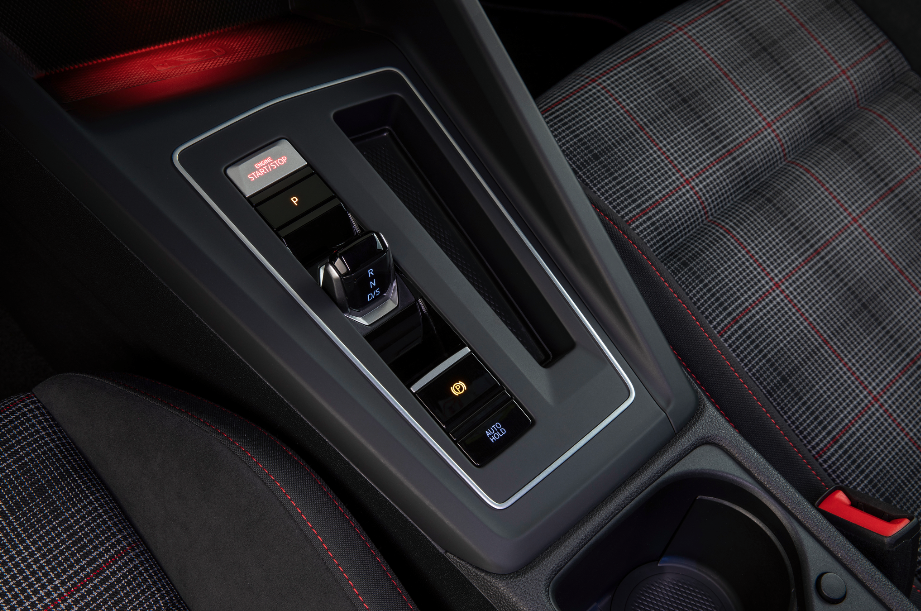
Adaptive chassis control (DCC) continuously reacts to the road surface and driving situation while taking account of various elements including steering, braking and acceleration manoeuvres. By means of the set driving profile mode, the driver can influence the reduction in body motion as desired. The required damping is calculated for each wheel and adjusted at the four shock absorbers within fractions of a second. This ensures that DCC always provides the highest level of driving comfort and ideal driving dynamics in conjunction with the Vehicle Dynamics Manager. In the latest DCC generation, the vehicle setup can be extended in INDIVIDUAL mode to go beyond the existing range of the fixed COMFORT, ECO and SPORT modes. The driver can accurately set and store their personal driving profile using a digital slider. Beyond the COMFORT setting, the body is “decoupled” from the road surface as much as possible, thus boosting driving comfort. Beyond SPORT mode, there is an extended setting range with maximum damping for minimised body movements and extremely direct vehicle handling for that unbridled GTI feeling.

Progressive steering is installed as standard in the new Golf GTI. This system has also been enhanced – running gear engineers set up the steering ratio more directly while applying new software algorithms and a new software application. How progressive steering works: conventional steering systems operate on the basis of a fixed gear ratio. However, the progressive steering in the Golf GTI applies a progressive gear ratio. This significantly reduces the effort required to steer when manoeuvring and parking. On winding country roads and when turning off, the driver will notice added levels of dynamism thanks to the more direct setup. It also means that the driver does not have to change their hand position as frequently. It takes a mere 2.1 turns of the steering wheel to turn it from stop to stop in the new Golf GTI. In terms of technology, progressive steering is essentially differentiated from the basic steering system by variable steering rack and pinion gearing as well as a more powerful electric motor. In contrast to systems with fixed steering ratio, which are always forced to compromise between driving dynamics and comfort, the gearing of the steering rack is considerably modified functionally using the steering stroke. Result: the transition between indirect steering response in the central range (driving straight ahead) and direct steering response in the event of larger steering wheel turn angles has been set up progressively to enable a considerably more agile steering response in situations demanding driving dynamics.
